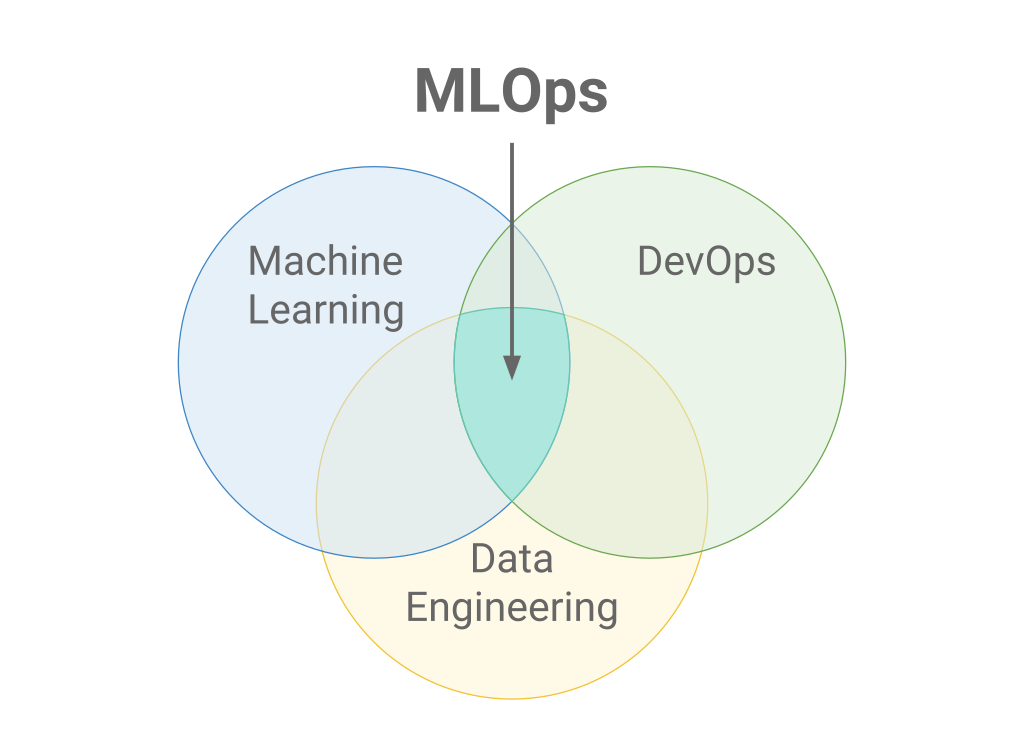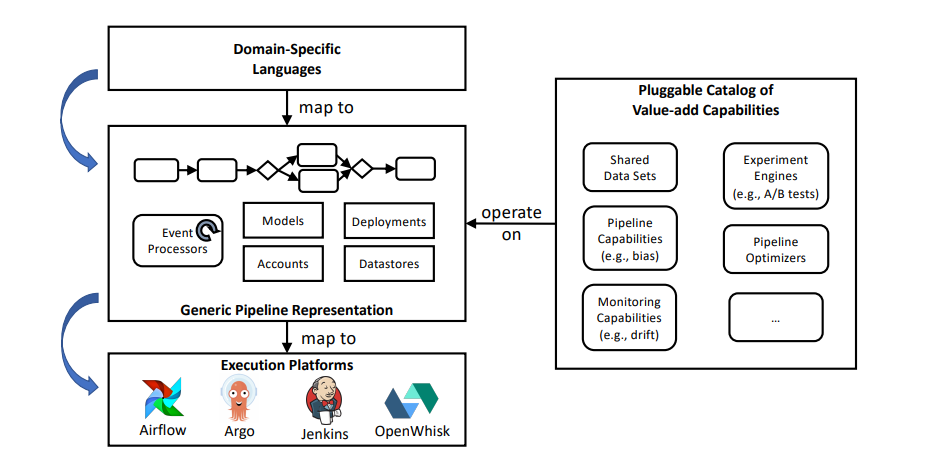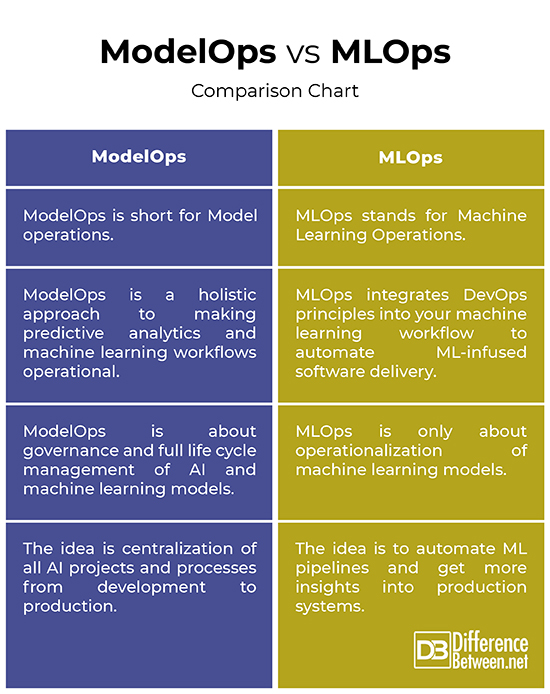Difference Between ModelOps and MLOps
People are often confused by the two recent yet popular terminologies – ModelOps and MLOps – because the two are largely being used interchangeably. However, ModelOps is believed to be more general than MLOps, as it is not only about machine learning models but any kind of model.

What is MLOps?
MLOps, short for Machine Learning Operations, is an engineering discipline that seeks to unify ML systems development and ML systems deployment in order to standardize and streamline machine learning life cycle management. The concept sounds familiar because it is inspired heavily from the concept of DevOps, which streamlines the process and practice of software change and updates. MLOps is a process for generating long term value while minimizing the risks associated with ML, data science, and AI projects. It is a collaboration between data scientists and the production or operations team to adopt MLOps best practices in order to deploy machine learning models into production at a large scale. MLOps is basically integrating DevOps principles to your machine learning workflow, bringing people and processes together to automate ML-infused software delivery.

What is ModelOps?
Model Operations for AI (ModelOps) is a holistic approach to making predictive analytics and machine learning workflows operational, putting them to work and using them to effect in a business so that teams would waste less time on those repetitive tasks and focus more on the things that actually matter. ModelOps, as defined by Gartner, is a set of practices that seek to automate a common set of operations that arise in data science projects, which include model training pipeline, version control, data management, experiment tracking, testing and deployment. It aims to take all predictive analytics and ML and AI models and make them operational. It helps you create project delivery pipelines with automate testing procedures that try to catch coding errors.
Difference between ModelOps and MLOps
Definition
– ModelOps is a strategic approach to making machine learning models and AI models operational. It is the effective life cycle management and governance of AI and machine learning decision models. It is a set of practices that seek to automate a common set of operations that arise in data science projects. MLOps, short for Machine Learning Operations, is the standardization and streamlining of machine learning life cycle management, which in an enterprise setting, is much more complex in terms of requirements and tooling.
Approach
– MLOps is inspired from heavily from the concept of DevOps, which streamlines the process and practice of software change and updates. MLOps is a combination of processes, practices and underlying technologies to deploy machine learning models into production at a large scale. It is collaboration between data scientists and operations team to automate ML-infused software delivery. ModelOps, on the other hand, aims to take all predictive analytics and ML and AI models and make them operational. It focuses on making ML models operational.
Focus
– MLOps is the DevOps for machine learning algorithms that aims to integrate DevOps principles into your machine learning workflow, bringing people and processes together to automate ML-infused software delivery. MLOps is only about operationalization of machine learning models. It aims to generate long term value while minimizing the risks associated with ML, data science, and AI projects. ModelOps, on the other hand, focuses on the governance and full life cycle management of all AI and machine learning and decision models.
ModelOps vs. MLOps: Comparison Chart

Summary
In a nutshell, MLOps is a subset of ModelOps wherein some aspects of MLOps and ModelOps overlap whereas others are distinct processes. MLOps is targeted at machine learning models specifically and provides monitoring of the performance of models, and the monitoring of the nature of the data. MLOps is basically the DevOps for machine learning algorithms, which is all about operationalization of machine learning models. ModelOps, on the other hand, is about governance and life cycle management of all AI and Machine Learning models and business models.
What comes under MLOps?
MLOps is specifically targeted at machine learning algorithms; in fact, it’s all about operationalization of machine learning models only. It is similar to DevOps and DataOps approaches that seek to increase automation in production models.
What does MLOps stand for?
MLOps is short for Machine Learning algorithms and is inspired heavily from the concept of DevOps, which streamlines the process and practice of software change and updates.
What is MLOps technology?
MLOps is collaboration between data scientists and production or operations team that seeks to unify ML systems development and ML systems deployment in order to standardize the continuous delivery of ML models in production.
What is MLOps Gartner?
According to Gartner, MLOps is a subset of ModelOps which focuses on the standardization and operationalization of machine learning models.
How do you implement MLOps?
MLOps is the key in mitigating the risks induced by the use of ML models and it is also an essential component to massively deploying machine learning efforts. They key stages of MLOps are data gathering and analysis, data preparation, model training, validation, serving and monitoring.
What is CI CD in programming?
CI and CD stand for continuous integration and continuous delivery, which are modern software development practices that help create a fast and effective process of bringing software and applications from start to production and to delivery in a seamless manner.
- Difference Between Caucus and Primary - June 18, 2024
- Difference Between PPO and POS - May 30, 2024
- Difference Between RFID and NFC - May 28, 2024
Search DifferenceBetween.net :
Leave a Response
References :
[0]Burk, Scott, et al. It's All Analytics - Part II: Designing an Integrated AI, Analytics, and Data Science Architecture for Your Organization. Florida, United States: CRC Press, 2021. Print
[1]Ameisen, Emmanuel. Building Machine Learning Powered Applications: Going from Idea to Product. California, United States: O'Reilly Media, 2020. Print
[2]Treveil, Mark, et al. Introducing MLOps. California, United States: O'Reilly Media, 2020. Print
[3]Dubovikov, Kirill. Managing Data Science: Effective Strategies to Manage Data Science Projects and Build a Sustainable Team. Birmingham, UK: Packt Publishing, 2019. Print
[4]Image credit: https://commons.wikimedia.org/wiki/File:ModelOps.png
[5]Image credit: https://commons.wikimedia.org/wiki/File:ML_Ops_Venn_Diagram.svg
